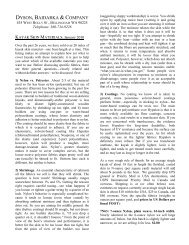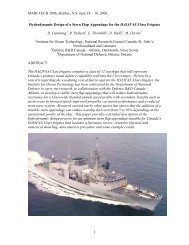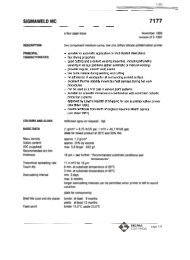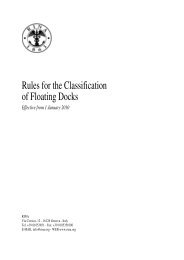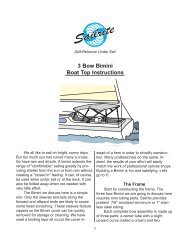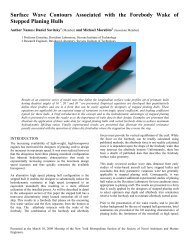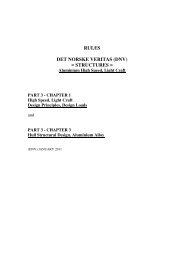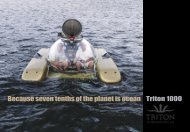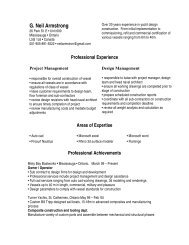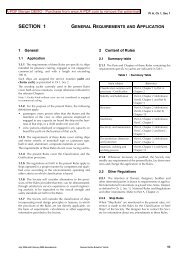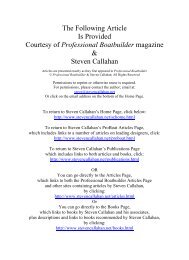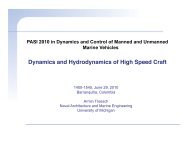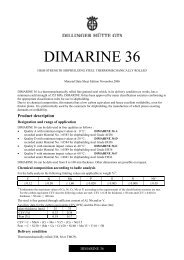Recent Applications of Hydrofoil-Supported- Catamarans - Boat ...
Recent Applications of Hydrofoil-Supported- Catamarans - Boat ...
Recent Applications of Hydrofoil-Supported- Catamarans - Boat ...
Create successful ePaper yourself
Turn your PDF publications into a flip-book with our unique Google optimized e-Paper software.
3Making use <strong>of</strong> the so-called hydr<strong>of</strong>oil free surface effect the Hysucat has a built-inautomatic trim-stabilizing characteristic, which allows for larger LCG shifts. The designallows a stable craft with a fixed wing foil system in the full speed range. Propulsionpower is down by 35% to 40% compared with similar Deep-Vee mono-hulls. SeeHoppe (1991,1991a, 1992 and 1995). Many craft were built after this principle rangingin size from 4.5m to 36m.The early hydr<strong>of</strong>oils were designed by use <strong>of</strong> NACA airfoil sections. However, it wasfound that the production <strong>of</strong> these foils for the larger craft was too expensivenecessitating numerical controlled cutting processes. Foil shapes were thereforedeveloped which allow cheaper production by use <strong>of</strong> rolled plate sections in weldedarrangements. High tensile steel <strong>of</strong> SAF 2205 or similar had to be used for the fasterHysucats , as the foils have to be very thin to prevent cavitation. Foil loads at top speedin wave passages are extremely high and can exceed the total weight force <strong>of</strong> the craft.Extensive strength calculations including Finite Element Analysis are design requisites forthe larger Hysucats.The Hysucat hydr<strong>of</strong>oil pr<strong>of</strong>ile sections have extended circular arc surfaces. Systematictowing tank tests were conducted with variation <strong>of</strong> the aspect ratio, angle <strong>of</strong> attack,depth <strong>of</strong> immersion and speed as little data on foil tests in extreme free surface effectare published. A second pr<strong>of</strong>ile section shape with a concave lower surface was alsotested and gave higher efficiencies in close surface approach. It is the preferred pr<strong>of</strong>ilesection for very fast Hysucats now.Most <strong>of</strong> the catamaran demi-hulls in the Hysucat project are <strong>of</strong> the fully asymmetricaldemi-hull type with a straight walled tunnel which allows for reduced hull interferenceand which gives the ideal flow conditions for efficient hydr<strong>of</strong>oil operation. The type <strong>of</strong>demi-hull has been proven to give the most sea friendly high-speed behavior. However,many Hysucats now on the sea, are existing catamarans for which a hydr<strong>of</strong>oil systemwas retr<strong>of</strong>itted afterwards. These so-called Hysucat conversions are more difficult tooptimize and have somewhat lower efficiencies.The Cape Town Company “T-Craft Marine” built a large number <strong>of</strong> 10m, 12m, 20m and22m Hysucat conversions. The hulls have been designed by “Bob van Niekerk,” wellknown fast craft designer in South Africa. These craft have shown that the Hysucatprinciple delivers practical high speed rough water work boats. The company closeddown in 1992 but some <strong>of</strong> their designs are still built with improved hull shape and foildesigns, by Stingray Marine and Waterfront Charters in Cape Town.



